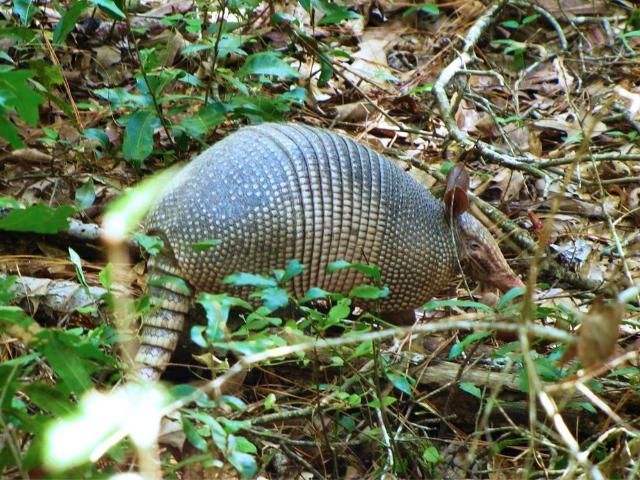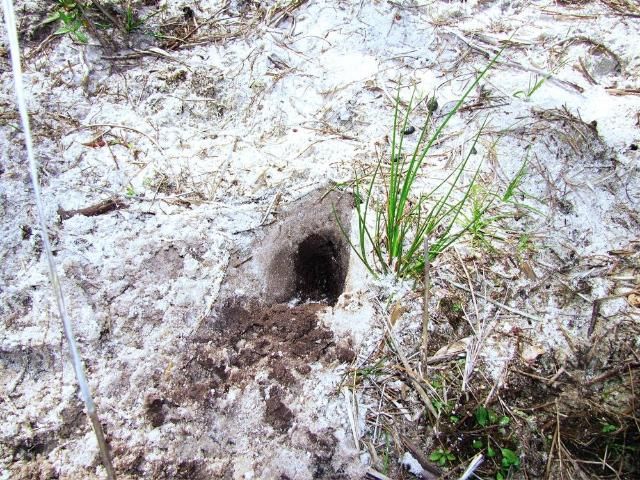The nine-banded armadillo (Dasypus novemcinctus) is considered an invasive species in Florida (Figure 1). Armadillo feeding activity causes damage in a wide range of locations such as lawns, flower and vegetable gardens, golf courses, sports fields, cemeteries, nurseries, and orange groves. Armadillos have been blamed for reducing bobwhite quail and sea turtle numbers because of their fondness for quail and turtle eggs. Armadillos are also blamed for causing structural instabilities when they dig burrows around and under buildings. In sum, they are one of the most significant nuisance pests in Florida and much of the Southeast.

Credit: Steve A. Johnson, UF/IFAS
The most common damage complaints against armadillos are from the extensive digging they do while searching for food. Armadillos feed primarily on invertebrates that live in the upper layers of the soil. Using its long nose and forefeet, a single individual may dig dozens of shallow holes 2–6 cm wide and up to 15 cm deep each night (Figure 2). Because armadillos prefer to dig in moist soil, their activity is concentrated in well-kept lawns and gardens—exactly where people are most sensitive to such destructive activity!

Credit: Steve A. Johnson, UF/IFAS
Armadillos first arrived in Florida during the 1920s and 1930s. They are considered an invasive species because they were brought by people and quickly began reproducing. By the early 1950s, they had spread throughout most of the state. The growing armadillo population in Florida in recent decades has increased the frequency of contact between armadillos and humans. This contact is of medical concern because nine-banded armadillos are the only animal (other than humans) capable of hosting the bacteria that causes leprosy. Leprosy has been detected in armadillos from Texas, Louisiana, Mississippi, Alabama, Georgia, and Florida. The method by which leprosy is transferred among organisms and the potential for armadillos to transmit leprosy to humans is not well understood.
Control Methods Currently Available
Most of the methods used to reduce damage caused by wildlife are not effective against armadillos.There are currently no repellents, toxicants, or fumigants registered for use with armadillos. Exclusion with fences is challenging because armadillos are good at both burrowing beneath and climbing over them. There are also no effective methods for baiting armadillos into traps. Although armadillos occasionally enter live traps when fencing material is used to divert them from habitual travel paths into trap entrances, capture rates are extremely low. A recent study in Georgia reported one capture for every 132 nights a trap was set open.
One of the most commonly recommended tactics for reducing armadillo damage is removing the foods armadillos are known to eat (i.e., killing invertebrates living in the soil). Because widespread application of insecticides can have negative side effects on non-target species and the environment, this is not a sustainable solution. Clearly, there is a need to develop more effective and efficient armadillo control methods.
The Search for Bait Materials
Two types of materials have strong potential to serve as bait to lure armadillos into traps: food items and smells from other armadillos.
Armadillos are generalists, meaning they consume a wide variety of foods. Approximately 75% of their diet by volume is insects, mostly beetles (Coleoptera). The remainder of the diet consists of other invertebrates (worms, insects, spiders), small amphibians, reptiles, mammals, birds, eggs, fruit, other plant material, and carrion (dead animals). This wide variety in armadillo diets makes the selection of a single item to use as a bait challenging!
Smells from other armadillos also have potential to attract armadillos. It is believed that armadillos communicate with one another through odors they emit through their anal scent glands. Odors produced by the scent glands of one armadillo may stimulate the curiosity of another.
To determine which materials have the greatest potential to serve as bait, we set up several tests. We captured 40 wild armadillos and maintained them in outdoor enclosures. We then compared armadillo interest in a variety of items including invertebrates commercially available from bait shops and pet stores, eggs, fruits, and scents collected from armadillo anal glands. The following materials were tested:
- crickets (Acheta domesticus)
- pond worms (Lumbricus terrestris)
- red worms (Eisenia fetida)
- wigglers (Pheretima hawayanus)
- meal worms (Tenebrio molitor)
- big red worms (Eisenia hortenis)
- glow worms (Eisenia hortenis, dyed bright colors)
- millipedes (Dipolopda)
- chicken eggs
- quail eggs
- avocado
- banana
- strawberry
- peanut butter
- vanilla wafer cookies
- pads containing odors from armadillos of the same gender
- pads containing odors from armadillos of the opposite gender
- unscented pads
Of the materials we tested, worms and crickets performed best. These baits attracted the attention of armadillos more quickly than the other materials, armadillos visited the locations where these baits were placed more often than locations with other potential baits, and armadillos spent significantly more time at the locations where these baits were placed than at all other locations.
Interestingly, although armadillos are known to eat eggs of quail, turkeys, sea turtles, gopher tortoises, lizards, and snakes in the wild, our tests suggested that eggs from domestic bobwhite quail and chickens were less attractive than worms and crickets. Eggs from domestic birds seem to have limited potential to serve as bait for armadillos.
Our tests also showed that armadillos have an extremely short perceptual distance: they do not recognize the presence of food items until they are within a few feet of the material. For this reason, it is unlikely that placing any of the preferred baits (or any other naturally occurring materials) in a trap will effectively lure armadillos into traps over long distances.
Conclusions
Armadillos preferred pond worms, wigglers, crickets, and red worms. Each of these materials is commercially available from bait stores and pet stores. Each is therefore readily accessible to anyone interested in baiting nuisance armadillos into traps. Crickets or worms can be placed in a bowl or a stocking and put into a live trap to attract the attention of foraging armadillos.
However, because armadillos do not seem to recognize potential prey items until they are very close by, trap placement is likely more important to capture success than selection of bait materials. Traps are most effective when placed in one of two locations: near the entrances to active armadillo burrows or along barriers (such as fences) in areas where armadillos regularly travel. It is wise to invest time searching for armadillo burrows and observing their travel paths because the chances of catching the offending animal will increase greatly if the trap is properly placed. The habit of armadillos to follow barriers can be used to your advantage: temporary garden fencing or wooden boards can be used to funnel armadillos travelling along such barriers into traps. Additional suggestions on how to funnel armadillos into live traps are available at https://edis.ifas.ufl.edu/pdffiles/UW/UW08200.pdf.
Additional Information
Armstrong, J. B. 1991. Extension wildlife damage management in Alabama. Proceedings of the Eastern Wildlife Damage Control Conference 5: 148–150.
Bruggers, R. L., R. Owens, and T. Hoffman. 2002. Wildlife damage management research needs: perceptions of scientists, wildlife managers, and stakeholders of the USDA/Wildlife Services program. International Biodeterioration and Biodegredation 4: 213–223.
Chamberlain, P. A. 1980. Armadillos: problems and control. Proceedings of the Vertebrate Pest Conference 9: 163–169.
Gammons, D. J., M. T. Mengak, and L. M. Conner. 2005. Evaluation of attractants for live-trapping nine-banded armadillos. University of Georgia WSFR–Wildlife Management Series 05–04.
Schaefer, J. Dealing with unwanted wildlife. University of Florida/IFAS Extension document WEC 20. Available at https://edis.ifas.ufl.edu/pdffiles/UW/UW07000.pdf.
Schaefer, J., and M. E. Hostetler. The nine-banded armadillo (Dasypus novemcinctus). University of Florida/IFAS Extension document WEC 76. Available at https://edis.ifas.ufl.edu/pdffiles/UW/UW08200.pdf.